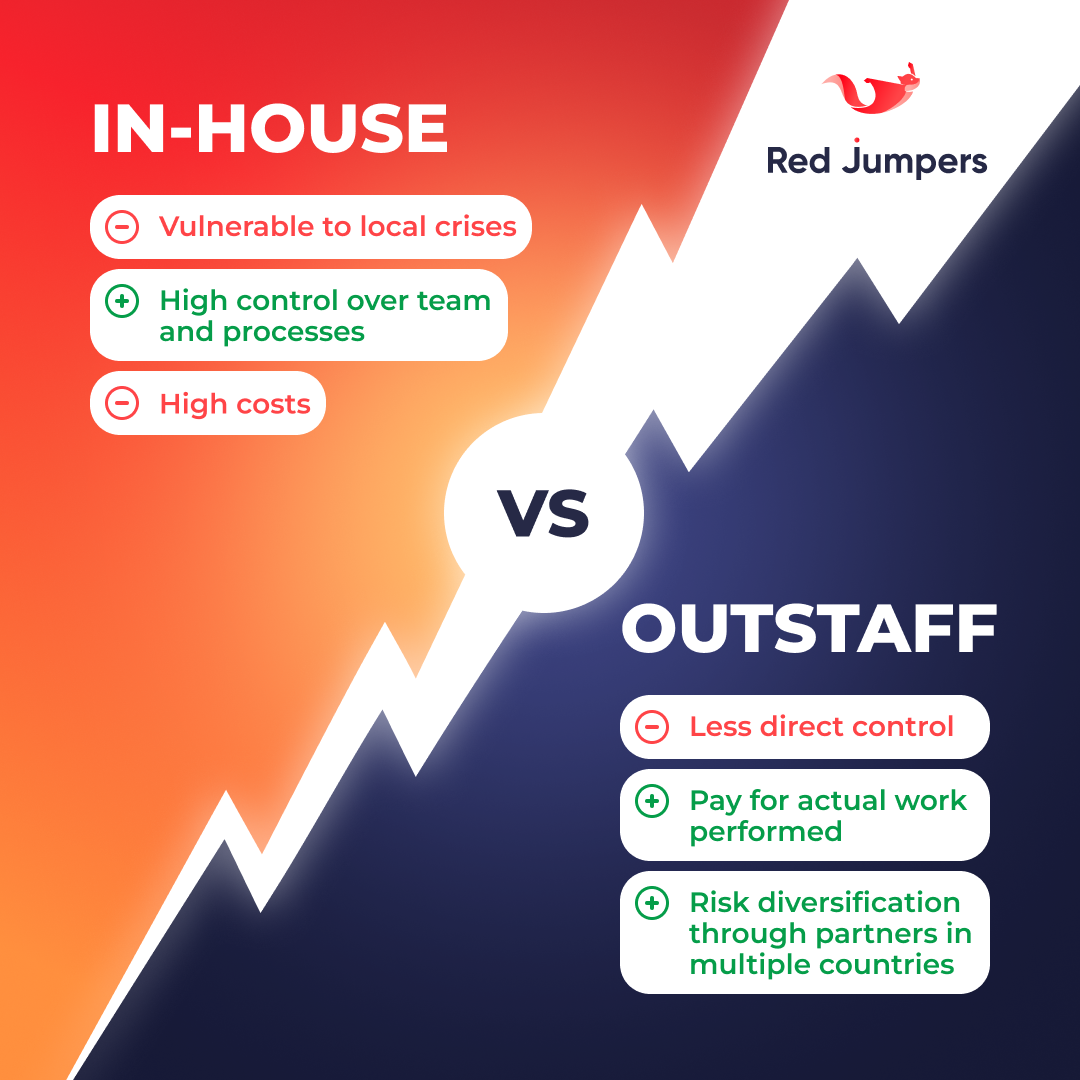- Outstaffing and In-House: Definitions
- 7 Reasons to Choose Outstaffing For Your Next Project
- 7 How to Choose an Outstaffing Company
- Conclusion
Outstaffing and In-House: Definitions
Outstaffing vs outsourcing vs an in-house team — which comes out on top? These are all popular approaches to IT project management, but at their core, they are fundamentally different; thus, it’s important to know what each of the models means.In-house work is handled within the company, by a department that’s hired and managed internally. In-house teams are usually located in the company’s offices. A business takes full responsibility for managing and paying in-house employees.Large companies mainly employ in-house teams to have more control over the development of their projects. Google, for instance, has in-house teams for its major development vectors — development, marketing, etc. The company has internal legal and consulting departments as well.Outstaffing/Outsourcing presumes relying on a third-party firm that will find a skilled employee to handle the main company’s projects and tasks. As opposed to in-house teams, outstaffing puts all employee maintenance expenses on the vendor, not the main office.While outstaffing is primarily seen as a way for SMEs to get access to a less expensive workforce, large-scale companies like IBM actively leverage the potential of the business model — the tech giant relies on over 130,000 Indian employees. Microsoft sources over 8,000 professionals overseas as well.Outstaffing and In-House: Definitions
To understand if in-house or outstaffing is the right choice for you, you must be aware of all the differences between the two. Here’s the comparison chart for both approaches that will help business managers make an informed decision.| IN-HOUSE | OUTSTAFFING | |
|---|---|---|
| Costs | Payroll Expenses. An Average Developer Salary In The US Is $78,000 Per Year, According To PayScale. Office Rental Costs; Equipment; Hiring Expenses. | Payroll Expenses. An Average Developer Salary In Eastern Europe Is $25,000 Per Year, According To PayScale. |
| Tax Return | Local Tax Rates — For Americans, The Tax Return Equals 21.7% From Income. | Developing Countries Have Lower Taxes For IT Companies. |
| Duration | Long-term. | Flexible, Fits Well For Short-Term Projects. |
| Control | Direct — A Company Fully Manages The Employee’s Work Process. | Indirect — A Company Can Control The Employee’s Work Process And Estimate Time Spent On Particular Tasks. |
| Risks | High — If A Project Fails, An In-House Department Will No Longer Be Needed. Long-Term Investments Like Recruitment Campaigns Will Not Pay Off As Well. | Low — The Main Company Can Terminate The Collaboration When Needed. |
7 Reasons to Choose Outstaffing For Your Next Project
Outstaffing is a flexible way to find professional developers for the most advanced projects. Regardless of whether you run an SME or a large-scale enterprise, here are seven reasons to consider implementing outstaffing.01. Shorter hiring and onboarding process
Gathering an in-house team is a multi-staged process. You have to hire an HR who’ll write copy for job openings, screen, and interview candidates. Then, you need to ensure the company’s offer is compelling enough to attract top-tier talent into the company. Finally, high employee turnover is a frustration most modern IT companies have to put up with.Outstaffing takes hiring and onboarding off your plate. Finding a reliable vendor is all a company manager needs to do. The outstaffing firm will be the one to find ways of recruiting, onboarding, and retaining talent.By sparing the company the trouble of scouting talent, you save on hiring campaigns and have more time to focus on the business’ core activities.02. Reducing operating costs
Maintaining an in-house department is a responsible and expensive task. Aside from affording an office space, you have to pay for equipment, proprietary project management technology, as well as additional office perks — coffee, snacks, etc. Electricity bills alone can make up for an impressive expenditure.With outstaffing, a business owner doesn’t have to pay office rent, bills, or cover other maintenance expenses.All the money that would otherwise be invested in sustaining an in-house team can be used for marketing campaigns, launching new products, etc.03. No location constraints
As you look for in-house employees, the range of options is limited to a city, if not an area.When outstaffing, the location concern is no longer an issue. You get to hire talent from all over the world, prioritizing expertise over the location.Also, thanks to the location flexibility, company managers that outstaff are not as affected by talent wars as those who have internal departments.04. Less commitment needed
Providing dozens of people with jobs is a responsibility business managers should only take once the project that is handled by a department is feasible. For risky undertakings, it’s better not to rush with building in-house departments. Contacting an outsourced firm is a safer, risk-free way to validate the idea since a business manager can terminate the collaboration if project fails.Also, running an in-house team presumes getting into the nitty-gritty of legal regulations and taxation — with outstaffing, all the responsibilities are assumed by the vendor.05. No need to spend time on educating employees
By contacting an outstaffing firm, you get access to skilled talent and no longer have to train junior employees. This way, a company owner only pays for the outcome of the project, and the outstaffing firm deals with all the team-building and education activities. A business manager can oversee or contribute to employee training — yet, it does not have to be your chief responsibility.06. A business can focus on its core activities
Maintaining several in-house departments puts a business manager at risk of refocusing on management, instead of offering high-quality products or services. Likewise, trying to manage software development singlehandedly will require too much attention to be focused on clients and getting exposure.By outsourcing software development and maintenance tasks to an outstaffing firm, businesses can be fully concentrated on their core activities, as well as promoting the company, investor pitching, and networking.07. Staffing flexibility
Expanding or narrowing down an in-house team is a pain in the neck for managers. In the first case, you will have to start hiring again, spending both money and time on filling job openings as soon as possible. In the second, a business manager has to fire employees, deal with likely reputational damage and dissatisfaction within the team.Outstaffing provides you with hiring flexibility. It takes no time to scale or reduce the number of employees, since all communication is handled by the vendor.How to Choose an Outstaffing Company
There’s no shortage of outstaffing vendors all over the world. While the factors that go into play when settling with an outstaffing vendor may vary, these are the tried-and-true tips to make the right choice.- Establish clear selection criteria. Outline what exactly you are looking for in a vendor — location, experience, positioning, preferred technology stack, and other factors. Having a clear idea of a vendor you would like to collaborate with narrows down the range of options to a manageable one.
- Choose a location for sourcing vendors. Depending on your priorities, it could be the closest one to the main office, the one with the lowest employee rates, or the most skilled talent.
- Check if the firm’s portfolio matches your requirements. It’s better to collaborate with a team that has handled projects similar to yours. This way, you will ensure IT professionals have enough technical and domain knowledge to create a high-quality product.
- Define the communication framework and channels. Before signing a service agreement, make sure you and the vendor are on the same page regarding the language, timing, and channels of communication.
Conclusion
Despite the acclaimed efficiency of in-house teams, choosing outstaffing as a way to hunt talent is a better fit in most aspects — costs, responsibilities, access to technologies, etc.The success of an outstaffing project heavily relies on the reputation of the vendor a business owner is onboarding. If you are looking for an outsourcing company, reach out to Red Jumpers agency. We have helped over 200 IT companies from all over the world find skilled talent in Eastern Europe. Filling in an application is all it takes to start getting CVs from top-tier candidates the next day.Contact us — our experienced team will help your company hire remote developers that will develop your next big tech project!We are pleased to announce that we have been named one of the Top IT Services Staffing Firms and Top Recruiting Agencies, by DesignRush for 2022.




